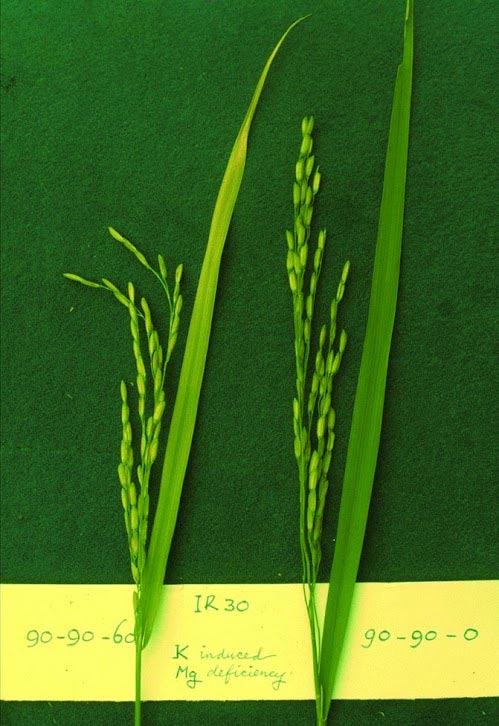Magnesium (Mg) deficiency

What it does
Magnesium (Mg) deficiency affects several enzyme activities in plants, including carbon dioxide (CO2) assimilation and protein synthesis, and the cellular pH and the cation-anion balance activation.
It may reduce grain quality (% milled rice, protein, and starch content).
Why and where it occurs
Magnesium deficiency is relatively rare especially in irrigated rice systems.
Magnesium deficiency is not frequently observed in the field because adequate amounts are usually supplied in irrigation water. It is more common in rainfed lowland and upland rice where soil Mg has been depleted because of the continuous removal of Mg without recycling crop residues or replacing removed Mg with mineral fertilizer. Many rainfed rice soils are inherently deficient in Mg.
This can occur on the following soil types:
- acid, low-cation exchange capacity (CEC) soils in uplands and lowlands, e.g., degraded soils in North Vietnam and coarse-textured, highly weathered acid soils in northeast Thailand, Lao PDR, and Cambodia
- coarse-textured sandy soils with high percolation rates and leaching losses
- leached, old acid sulfate soils with low base content, e.g., in Thailand
How to identify
Check the plant for the following symptoms:
- orange-yellow interveinal chlorosis on older leaves
- plants pale-colored with interveinal chlorosis first appearing on older leaves and later on younger leaves as deficiency becomes more severe
- green coloring appears as a "string of beads" in which green and yellow stripes run parallel to the leaf
In severe cases, chlorosis progresses to yellowing and finally necrosis in older leaves. Leaf number and leaf length are greater in Mg-deficient plants, and Mg-deficient leaves are wavy and droopy due to an expansion in the angle between the leaf sheath and leaf blade.
With moderate deficiency, plant height and tiller number are not affected greatly. Also check for:
- reduced number of spikelets and reduced 1,000-grain weight
- Iron (Fe) toxicity may be more pronounced where Mg is part of multiple nutrient deficiency stress involving Potassium(K), Phosphorus (P), and Calcium (Ca).
Why is it important
Magnesium deficiency can occur throughout the growth cycle of the crop. However, it is not very common in irrigated rice and thus tends to be of little economic significance.
How to manage
- Apply sufficient Mg fertilizer, farmyard manure, or other materials to balance removal in crop products and straw.
- Reduce percolation rates (leaching losses) on coarse-textured soils by subsoil compaction.
- Reduce losses from erosion and surface runoff by appropriate soil conservation measures in upland systems.
There is currently no practical treatment option for Mg deficiency. Where possible:
- Apply Mg-containing fertilizers. Rapid correction of Mg deficiency symptoms is achieved by applying a soluble Mg source such as kieserite or Mg chloride.







